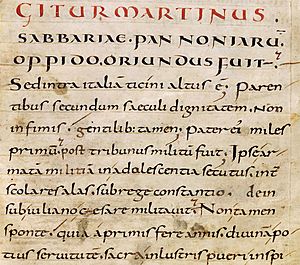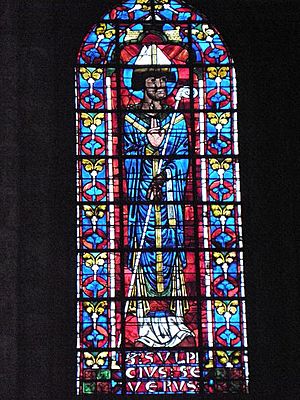Sulpicius Severus facts for kids
Sulpicius Severus (born around 363 AD, died around 425 AD) was an important Christian writer. He came from Aquitania, which is now part of France.
He is famous for two main works: a history book about sacred (holy) events, and a life story of Saint Martin, a well-known bishop.
Contents
Life of Sulpicius Severus
Almost everything we know about Sulpicius Severus comes from his own writings. We also learn about him from letters written by his friend, Paulinus, who was a bishop. A short biography by the historian Gennadius of Massilia also gives us some details.
Early Life and Education
Severus was born into a noble family in Aquitaine. He received an excellent education. He learned a lot about the culture of his time, especially in Latin literature. He studied law in Burdigala (modern-day Bordeaux) and became a skilled lawyer. His knowledge of Roman law can be seen in his writings.
He married the daughter of a rich family, but she died young. They did not have any children.
Becoming a Christian Writer
Around this time, Severus was greatly influenced by Saint Martin, the bishop of Tours. Saint Martin inspired Severus to use his wealth to help poor Christians. He also decided to dedicate his life to good deeds and to understanding God.
This decision made his father unhappy. However, his mother-in-law encouraged him. His friend Paulinus said that Severus chose to follow Christ. He valued the teachings of the "fishermen" (meaning the apostles) much more than his earlier "Tullian learning" (meaning his classical education).
Gennadius tells us that Severus became a priest. We do not know much about his work as a priest. Later in life, he was said to have been influenced by some different ideas about faith, called Pelagianism. However, he later changed his mind and punished himself for it. He spent most of his time near Toulouse. He wrote mainly to support Christian beliefs.
Martin's Influence on Severus
Severus was a scholar and a speaker, very familiar with the world. Saint Martin was a simple bishop from Pannonia, who strongly believed in living a monastic life. He was known for his visions and miracles. Even though they were very different, Saint Martin's spirit deeply influenced Severus.
Severus's writings are important because they show the ideas and influence of Saint Martin. Martin was one of the most important church leaders in Gaul (ancient France).
Works of Sulpicius Severus

The Chronicle
Severus's main work is the Chronicle (also called Sacred History). He wrote it around 403 AD. It is a summary of holy history from the beginning of the world up to his own time. He left out events from the Gospels and the Acts of the Apostles. He did this so that his shorter book would not take away from the importance of those events.
This book was used as a textbook in European schools for about 150 years. It is a very important source for understanding the history of Priscillianism. It also contains useful information about the Arian controversy, which was a big debate in the early church.
Severus wrote his Chronicle to help both new Christians and educated people. He wanted to show that holy history could be written in a style that people who enjoyed famous Roman writers like Sallust and Tacitus would appreciate. His writing style is clear and almost like classical Latin.
Severus's work is interesting because it gives us hints about his own time. More importantly, it tells us about the struggle against the Priscillianist heresy. This was a set of beliefs that caused problems for churches in Spain and Gaul, especially in Aquitaine.
Severus strongly supported Saint Martin's views on this issue. Martin had stood up to Magnus Maximus, a ruler who controlled a large part of the Western Roman Empire. Martin criticized Maximus for attacking other rulers and for how he treated the church. Severus often pointed out the crimes and mistakes of rulers. He even said that priests could sometimes be crueler than rulers. This was because some bishops had pushed Maximus to execute Priscillian and his followers. Martin, however, believed that the church should not use state power to punish people for their beliefs.
Severus also agreed with Saint Martin's views on the wealth of the church. When describing how the land of Canaan was divided, Severus noted that the tribe of Levi (who were priests) did not receive any land. This was so they could focus on serving God. Severus wrote that clergy in his own time seemed to have forgotten this lesson. He said they had a "passion for possessions." This shows us why many good people at the time were drawn to monasticism, a life of living apart from the world.
Severus also wrote about the Council of Rimini in 359 AD. At this meeting, bishops debated whether they should accept money from the emperor for their travel costs. Severus approved of the British and Gaulish bishops who felt it was wrong to owe money to the emperor. He believed the church should be independent and above the state.
The Life of Saint Martin and Other Works
Severus's Life of Saint Martin was very popular during the Middle Ages. His dialogues and letters about Saint Martin were also well-liked. These works helped Saint Martin become very famous throughout the Middle Ages as a saint who could perform miracles.
The Life of Saint Martin is not just a biography. It is a collection of miracles, told as if Severus completely believed them. He thought that the power to do miracles showed how holy someone was. He believed true holiness could only be reached by living apart from the world.
In his first dialogue, Severus describes the life of monks and hermits in the deserts near Egypt. He says that their virtue was shown by how wild animals would obey them. However, Severus was not blind to the problems of monastic life. The same dialogue shows he knew about its dangers.
The second dialogue adds more information to the Life of Saint Martin. It tells us more about Martin's life as a bishop and his ideas. These two dialogues sometimes mention interesting people from that time. For example, in one part, Severus describes the debates in Alexandria about the writings of Origen, another Christian writer. Severus believed that Origen was a great writer in some parts of his work, but made serious mistakes in others.
Severus also wrote three letters about Saint Martin's death. Other letters he wrote, for example, to his sister, about the love of God and giving up worldly things, have not survived.
Other Attributed Works
Some other letters have been linked to Severus, but many experts believe they were not written by him. There is also a World Chronicle by someone called Sulpicius Severus, but it was written in Spain in the 500s and is not by the Sulpicius Severus this article is about.
See also
 In Spanish: Sulpicio Severo para niños
In Spanish: Sulpicio Severo para niños
- Sulpicia (gens)


